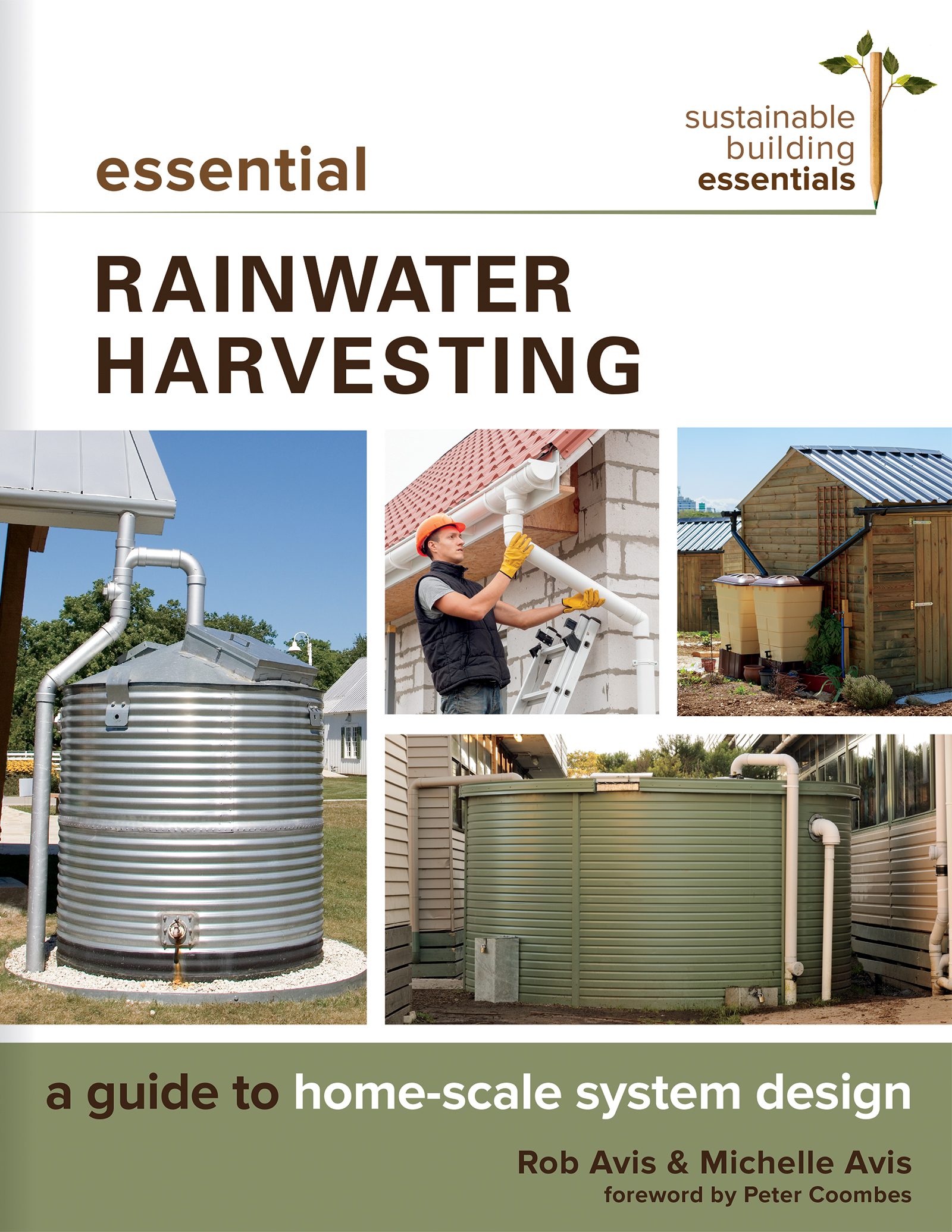
Over the past few years, many people have been looking to rainwater harvesting systems to help ease the anxiety of unreliable weather. If this has been something you’ve been dreaming of adding to your property, Michelle and Rob Avis outline everything you need to get started. Essential Rainwater Harvesting: A Guide to Home-Scale System Design is a comprehensive manual for designing, building, and maintaining water harvesting systems for the warm and cold climates of the world. If you are still in the dreaming phase, this excerpt might help you understand what questions you need to ask and have answered before you start designing your dream rainwater catchment system.
Introduction to Rainwater Harvesting
Order of Design Priorities
For a property to be truly sustainable and resilient, its occupants must have a safe and dependable supply of water, along with protection from the dangers of drought, flooding, and erosion. Recognizing the management of water — a source of life, and source of risk — as central to the success of an environmentally integrated system, it is always the first consideration when we design any property.
There are many elements to consider related to water when in the early design stages: potential water sources (municipal water, groundwater, surface water, rainwater, etc.), watershed management, landscape water retention/diversion/distribution, land-shaping (ponds, swales, collection, drains), infiltration, overflow management, storm water, water reuse, septic, and more.
In practice, we most often see homeowners purchase property, build a house, then try and figure out how to manage and supply water to that structure. The correct order of design priorities (water first, infrastructure next) is completely missed in most modern-day design. To most successfully achieve sustainability or resilience, water planning must be a priority in the initial design stages. An understanding of how volumes can be minimized/optimized, where water will come from, where it might be stored, and where it will go should be considered before even starting out on the design and placement of any building.
![A model of a resilient property located in a cold climate. The water, energy, and food systems include redundancy and can be described as efficient, productive, appropriate, and interconnected. Credit: Verge Permaculture/ S. Andrei ]](https://newsocietypub.tempurl.host/wp-content/uploads/2024/06/houseofthefuturefinal180328_ps-1024x683.jpg)
Water-Harvesting Earthworks
If the scope of your project is larger than a simple rooftop RWH system, and you (1) want your home integrated within a lush, biodiverse environment that restores fertile soil, sustains plants, wildlife, and humans, and you’d (2) like your property to be drought-proof and/or minimize the risk of fire, then you’ll absolutely want to consider how your rooftop RWH system fits in as part of a much larger integrated water design.
One of the ways we do this in our consultancy practice is by thinking of the landscape and soils surrounding the home as the primary water storage system. We can enhance and improve water infiltration and storage with careful consideration of property elevations and any appropriate water-harvesting earthworks such as rain gardens, swales, diversion drains, ponds, etc.
Our favorite resources for planning and designing landscape water-harvesting earthworks are included in the Resources section at the back of this book.
![Access pathways shown overlaid on the base map.]](https://newsocietypub.tempurl.host/wp-content/uploads/2024/06/access-rev_ps-1024x355.jpg)
Improving Soil Water-Holding Capacity
Whether rain falls directly on the ground, or is directed to landscape from tank overflows or water reuse strategies, if the ground surrounding your home is hard and compacted, the water will not infiltrate and will be virtually ineffective. Therefore, when it comes to landscape hydration for supporting biology, gardens, food production, or ecosystem services in general, your best bet is to make sure that the soil on the property is healthy and has high water-holding capacity.
How to do this? Well, soil water-holding capacity increases significantly with even a slight increase in soil carbon content. A 1% increase in soil carbon on your property will store an additional 168,000 liters/hectare (17,960 US gal/ acre) (Jones, 2010). This also makes soil storage the most cost-effective way to increase your overall property water stores. Consider that to store this same volume of water in tanks would cost you anywhere from $30,000–$70,000 in infrastructure.
Because carbon content increases when you support soil biology and soil health, there are three primary practices for increasing the water-holding capacity of your land:
- Keep the soil covered (no bare soil) with living plants, year-around if possible.
- Maximize diversity in crops and plant species.
- Avoid the use of synthetic fertilizers, fungicides, insecticides, and herbicides.
Best of all, adhering to these practices not only increases the water-holding capacity of your landscape, it also builds upon and enhances your natural capital and increases your overall sustainability and resilience through increased biodiversity, improved ability to grow nutrient-dense food, and reduced atmospheric carbon content, turning your “footprint” into a positive one.

Learn More
Again, we advise you to remember the importance and benefits of considering your rooftop RWH system as simply a small part of a much larger strategy for full-property water security, sustainability, and resilience. See this as an opportunity to create an integrated natural ecosystem that buffers you against the impacts of disaster while it increases the long-term economic and environmental value of your property.
In addition, changing our relationship with water has enormous implications and a large positive environmental impact when you consider the global crises we are facing with respect to biodiversity loss, food insecurity, and climate change. But going forward, we are going to narrow our focus in this book and keep it to the essentials of rooftop RWH system design.
Make sure you check out the other titles in the Sustainable Building Essentials series, and for more information on full-property design, including our favorite books, recommended courses, resources, and blogs on related subjects such as permaculture design, sustainability, soil and soil health, see the Resources and References section at the back of this book.

Design Scenarios
Now that you understand how the RWH system fits (or may fit) within the larger context of water design for your property, it’s time to narrow down your RWH design scenario.
Are you in a remote off-grid location? Are you in an existing house in the city? Are you building a new building or retrofitting an existing building? What are your water supply options?
What about your climate? Are you in a cold climate with ground frost in the winter? Is it an arid climate? Are your rainfall patterns uniform throughout the year or does rain come in certain seasons?
Depending on the answers to the above, your RWH system may be simply a small piece of a household water-supply plan, or it may be designed to supply all of your water needs at all times.

There are many permutations of a RWH system, but the three most common household scenarios we see with our clients are:
- Supplemental supply: rainwater as the secondary system, with a primary system in place.
- Primary supply: rainwater as the primary system, with secondary system in place.
- Off-grid supply: rainwater as the primary system, with no secondary system.
In the above scenarios, the primary or secondary system could be a municipal water supply, a groundwater well, gravity-fed or pumped system from surface water on the property, or even trucked-in water.
![Downspout filter on an off-grid cabin.]](https://newsocietypub.tempurl.host/wp-content/uploads/2024/06/leaf-eaters-on-an-offgrid-cabin_ps-1024x576.jpg)
In Scenario 1, the RWH system is there for specific or supplemental water supply, such as irrigation. Sized usually to only meet specific loads (like toilet flushing), its intended use is either as supplementary supply or as an emergency system, or as both.
In Scenario 2, the RWH system could be designed to meet most (if not all) of the demand over the course of the year, and the secondary system is in place to shave off the peak demands, as well as kicking in in the event of drought or low rainfall. This can be a cost-effective strategy for supplying a majority of your needs with rainwater, especially when a municipal or groundwater supply is already in place.
In Scenario 3, the RWH system must supply all of the demand, all year round. Here, there is a far lower risk tolerance for a zero rain tank balance than in scenario 1 or 2, and this must be factored into the design of the system.

Each of these most-common RWH design scenarios has different functionality and different risk considerations. In the next chapter we’ll present typical design considerations and approaches for each. And even if your particular design and usage scenario is not exactly as described above, you should easily be able to apply the presented design thinking and strategizing to your particular needs.






